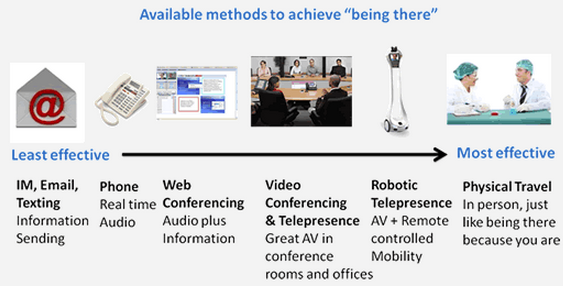Future Now
The IFTF Blog
From Telepresence to Copresence
Have you seen this hysterical four minute video called A Conference Call In Real Life? If you haven’t, treat yourself to a watch right now:
This video shows how ridiculously ineffective today’s remote collaboration tools can be. The problem with today’s telepresence solutions is that we are fixated on approximating face to face interactions across distance—even when it’s clear that it’s not cutting it. So how did we get here?
Telepresence: Designing “As If You Were There”
Tele- (def.) prefix meaning to or at a distance. One of the breakthrough technologies that helped us to think about connecting across distance, of course, was the telephone. It transmitted voice across physical space, and people remarked on how you could hear someone “as if they were in the same room.”
Fast forward to today’s telepresence solutions for telework, telemedicine, and the like. The design objective is still to create a feeling “as if you were there.” Yet it might be time to rethink the assumption that the more closely we can re-create face to face interactions, the more effective we will be at collaborating across distance. Take a look at how one robotic telepresence firm is articulating its value proposition in precisely this way:

Source: Robotic telepresence firm, VGO: www.vgocom.com/solutions
In the next decade, this unexamined assumption is ripe for disruption.
Attentional Proximity is More Important than Physical Proximity
It’s a familiar scenario: you’re in a room with six other people, and that guy in the corner absentmindedly trolls his twitter feed, occasionally nodding and interjecting an “mmhm” to indicate he is following along. You wonder...how is it possible he doesn’t realize how obvious it is that his mind is somewhere else? Moments like these remind us that it’s possible to have physical proximity--sharing a close physical space--without having attentional proximity.
Attentional proximity is all about paying attention to the same thing, at the same time, with all of the social cues that let others know where your focus is. It’s the social experience of a reciprocal turn toward each other, and it can happen irrespective of physical distance.
As we design tools and processes for remote collaboration, what if we re-envisioned this end state of “being there” in the physical sense, and instead started designing for attentional proximity, regardless of where we're located? If we do this right, the next decade will usher us into an era of what sociologists like Shanyang Zhao call copresence; a subjective sense of shared time and place.
Technology Drivers: Signals of Change
In the same way that face-to-face interactions are defined by physical proximity, copresent interactions are defined by attentional proximity. This has been true since the time of the telephone, but what's different today is that a suite of technologies has the potential to make attentional proximity easier, more immersive, and ultimately more useful. Together, these tech drivers will change the way we collaborate across distance in the next decade:
Ambient Collaborative Prompts like Perch, Whereabouts Clock, and Goodnight Lamp which invite people to signal their presence and availability, leaving cues for cooperative behavior in the environment, awaiting the right moment for activation. These kinds of cues will help teams to have an at-a-glance view of where collaborators are at a given moment, and to infer what they might be paying attention to.
Real-time Affective Feedback mechanisms like Us+, a Google Hangout plug-in that analyzes speech and leverages facial recognition to provide conversation partners with real-time feedback loops for more engaging interactions. What if a speaker could see how bored or emotionally invested their audience is in real-time, and adjust accordingly?
Multi-sensory Communication, to expand our perception of collaborative moments beyond simply audio and visual channels. Scentee leverages our olfactory sense, for instance, or haptic wearables like TapTap, or Ping, the social network garment. These kinds of tools add some of the human element to copresent collaborations, making it more immersive and fun.
AI-Assisted Conversation Tools like MindMeld, that “listen in” on conversations to serve up relevant resources in real-time. Imagine being able to leverage a new kind of in-convo datastream, weaving in information that augments the knowledge of your fellow collaborators.
Micro-location Context Sensing, powered by tools like iBeacon that combine with anticipatory calendaring via Google Now, Osito or Tempo AI and microwork platforms like ODesk in order to create just-in-time dream teams for collaborating across distance. Who would you want to invite to brainstorm with you if you could seamlessly route just the right human to the job based on their context at the moment you need them? Or if a person on your "dream team" had a calendar programmed to anticipate when they might need to be patched into a copresent conversation, so that it automatically rearranges appointments in order to make it possible?
The technological tools are actually further ahead than process design for cooperation across distance. By developing process design around these currently-fragmented tools, it is plausible that we’ll see breakthroughs in the next decade. The result? We’ll share time and place in entirely new ways.
Copresence: Designing for Better than F2F
Do you want to be stuck with Conference Call IRL forever? I don’t. Instead of designing for F2F, we need to start designing for Copresence. Here’s what a world of 2025 might look like as we take this new starting point:

For more on IFTF's work on Copresence, check out this 2m35s video by Sara Skvirsky, and CoPresence4Good, a project by IFTF Future for Good Fellow, Sam Gregory.
For More Information
For more on IFTF’s work on CoPresence, take a look at:
- A commentary and short video on CoPresence based on #10YF2014 by Sara Skvirsky
- CoPresence4Good, a project by IFTF Future for Good Fellow, Sam Gregory



